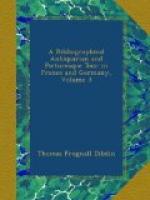I must bid you farewell in haste. I start for Vienna within twenty minutes from this time, and it is now nearly-mid-day. But ere I reach the capital of Austria, I hope to pay a string of MONASTIC VISITS:—beginning with that of St. Florian, about a dozen miles from this place, just before you reach Ens, the next post town; so that, ere I again address you (which cannot be until I reach Vienna,) I shall have made rather a rambling and romantic tour. “Omne ignotum pro magnifico”—yet, if I mistake not; (from all that I can collect here) experience will confirm what hope and ignorance suggest.
[90] Vol. ii. p. 352-3.
[91] See p. 217 ante.
[92] It should seem, from the pages of PEZ and NIDANUS,
that Charlemagne
was either the founder, or
the patron, or endower, of almost every
monastery in Germany.
Stengelius, however, gives a a very romantic
origin to the foundation of
Chremsminster. “The eldest son of Tassilo,
a Duke or Elector of Bavaria,
went out a hunting in the winter; when,
having been separated from
his companions, in a large wood, he met a
wild boar of an enormous size,
near a fountain and pool of water.
Notwithstanding the fearful
odds between them, Tassilo gallantly
received the animal upon the
point of his hunting spear, and
dispatched him with a tremendous
wound: not however without a fatal
result to himself. Rage,
agony, and over exertion... proved fatal to
the conqueror: and when,
excited by the barking of the dogs, his
father and the troop of huntsmen
came up to see what it might be, they
witnessed the spectacle of
the boar and the young Tassilo lying DEAD
by the side of each other.
The father built the MONASTERY of
CHREMSMINSTER upon the fatal
spot—to the memory of his beloved but
unfortunate son. He endowed
it with large possessions, and his
endowments were confirmed
by Pope Adrian and the Emperor
Charlemagne—in
the year 777. The history of the monastery is
lost in
darkness, till the year 1046,
when Engelbert, Bishop of Passau,
consecrated it anew; and in
1165, Diepold, another Bishop of Passau,
added greatly to its possessions;
but he was, in other respects, as
well as Manegold in 1206,
a very violent and mischievous character.
Bishop Ulric, in 1216, was
a great benefactor to it; but I do not
perceive when the present
building was erected: although it is
possible there may be portions
of it as old as the thirteenth century.
See Pez: Script.
Rer. Austriac., vol. i. col. 1305, &c.:
vol. ii.
col. 67, &c. At the time
of publishing the Monasteriologia of
Stengelius, 1638, (where
there is a bird’s-eye view of the monastery,
as it now generally appears)
Wolffradt (or Wolfardt) was the
Abbot—who, in the
author’s opinion, “had no superior among




